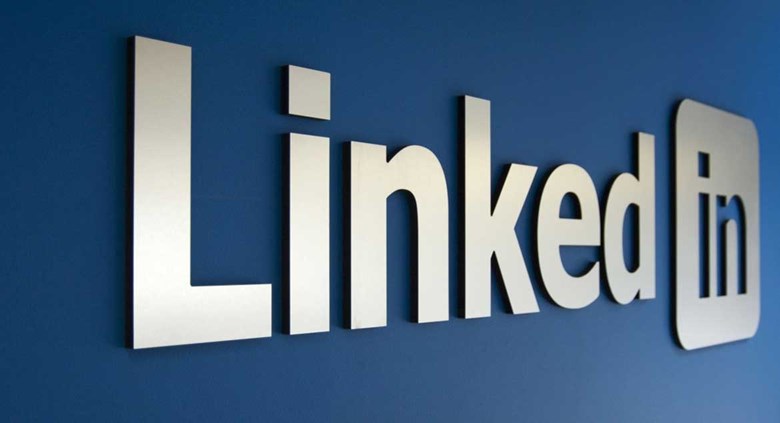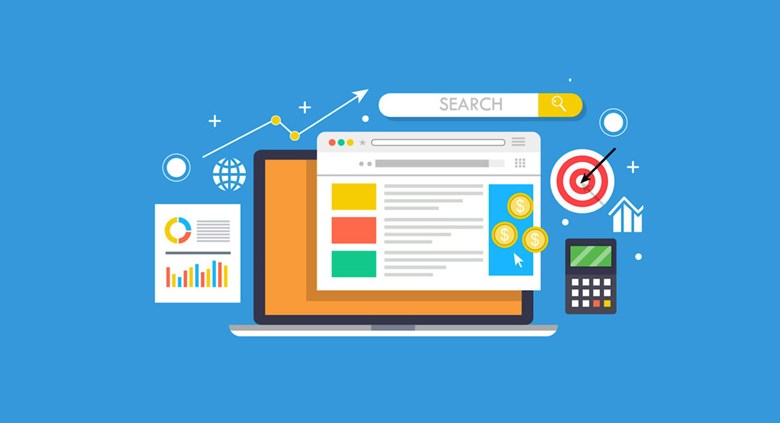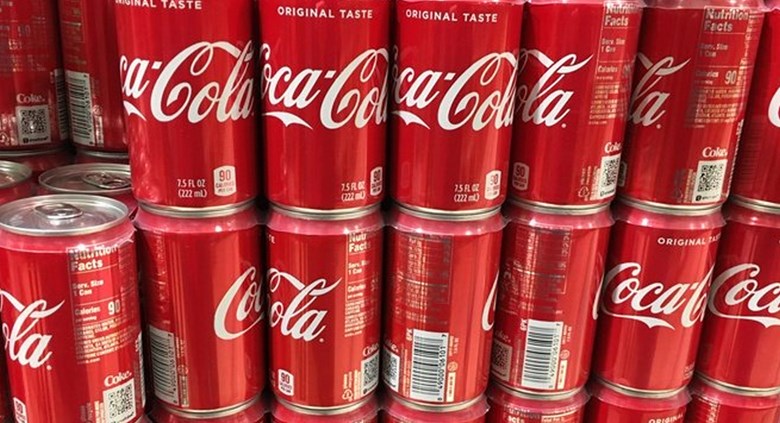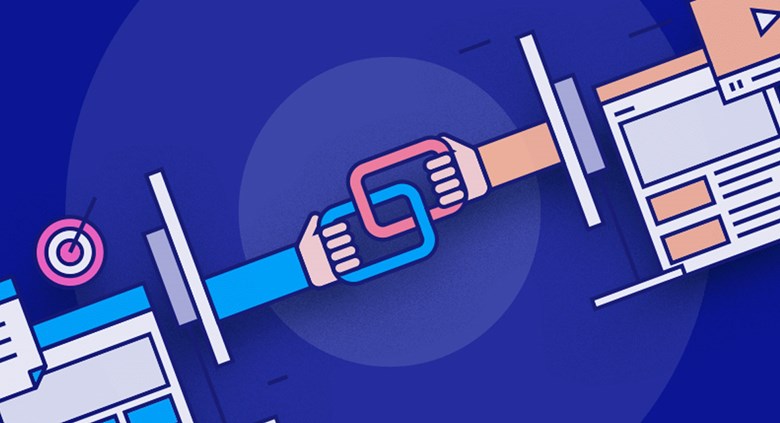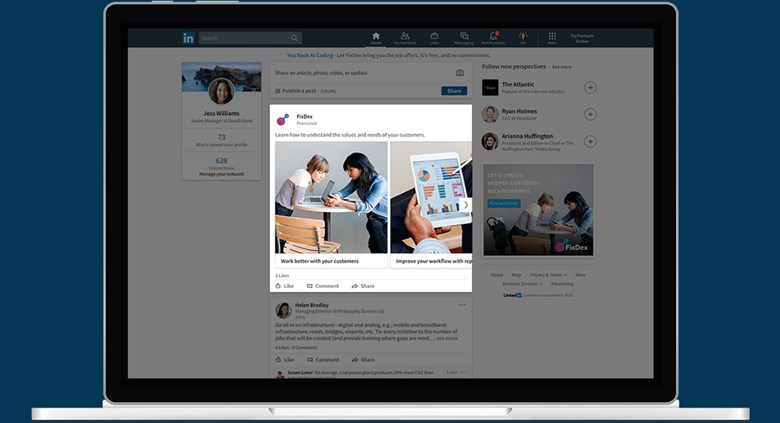Actualités
Coperon Technologies

Actualités technologiques !
sep 4, 2020ecommerce
A Corona Christmas: Why physical stores will power online shopping this holiday season
Most shoppers are more likely to make an e-commerce purchase if they can return the item in a local store.
A burning question this holiday season is whether people will return to physical stores or buy substantially everything online? The Mary Meeker formulation is: what percentage of retail spending will move online? But that binary “brick and mortar vs. e-commerce” narrative is crude and fails to appreciate the role stores play in driving online sales.
Indeed, a more interesting question is to what degree traditional retailers will be able to leverage physical stores for competitive advantage in their battle with Amazon and other pure play e-tailers? In the past, retailers with stores and e-commerce have treated them as entirely distinct channels, with different P&Ls and separate operational teams. Only recently have major retailers recognized how stores and e-commerce support one another and started to integrate those efforts (e.g., curbside pickup and seeing physical stores as ready-built distribution centers).
The dominant working assumption is that almost all holiday shopping will happen online and that stores will play a limited or secondary role. That would flip the script in terms of dollar volume compared with past years. Yet, even if the majority of buying happens online, the presence of local stores will factor significantly into consumer decision-making.
Will Prime Day kill Cyberweek?
Shoppers this holiday season are likely to be budget conscious, more selective and less impulsive than last year – especially if most shopping is done online, where browsing and spontaneous buying are typically less likely.
A Numerator survey of 2,000 adults asking about Labor Day shopping intentions could be predictive of future holiday shopping behavior. The survey found 49% of consumers said they would be spending less than last year; only 6% expected to spend more.
From this we can extrapolate – unless there’s dramatic improvement in the economy – that holiday shoppers will be more selective and value conscious than last year. That will mean pervasive discounting with a side of free shipping to coax shoppers to buy. Yet retailers have been discounting for months to boost online sales, so consumers may need even more incentives.
In the realm of online advertising, we’re likely to see aggressive competition among retail marketers for visibility at both top and bottom of the funnel. And it’s all likely to happen much earlier this year, as retailers seek any advantage to rise above the competitive noise. As this week’s IAB data suggested, Google and Facebook are likely to be the direct beneficiaries of this increased digital ad spending.
Black Friday, Cyber Monday and related shopping holidays will potentially see less concentrated purchase volume this year. Amazon Prime Day is reportedly coming in October, which will mean competitors will also be making an early promotional push at the same time. That event may take the wind out of the traditional Cyberweek sales if people spend their money early.
Hunger for normal shopping, but also fear
The Black Friday in-store experience, if it happens, is going to be very muted compared to past years. Roughly half of consumers express a fear of catching COVID while in a store, according to a new multi-country consumer survey from in-store marketing solutions company Mood Media.
Most people say they still won’t go to the mall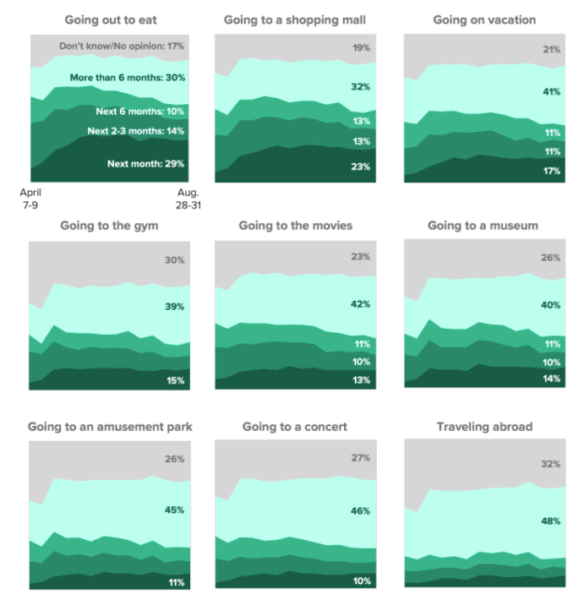
Pent-up consumer demand for retail normalcy and fear co-exist in the U.S. In countries where the pandemic has subsided, consumers are returning to stores. The Mood Media survey found that 71% of global respondents said they now felt comfortable going back into stores. This was to some degree contingent upon retailer safety precautions.
The survey also found that 67% of global shoppers had already returned to non-essential retail stores; the figure in the U.S. was 60%. This seems to contradict other survey data showing widespread concern. Only 10% said they “would never go back” to their old habits (presumably traditional retail shopping) after the pandemic is over.
As indicated, a large percentage of American consumers still express anxiety about going into retail stores. A late-August Morning Consult survey found that only 36% of consumers were willing to visit a shopping mall in the next 2 – 3 months. And if consumers act in accordance with those attitudes, stores will see considerably less foot traffic than last year.
Discount in-store shopping has recovered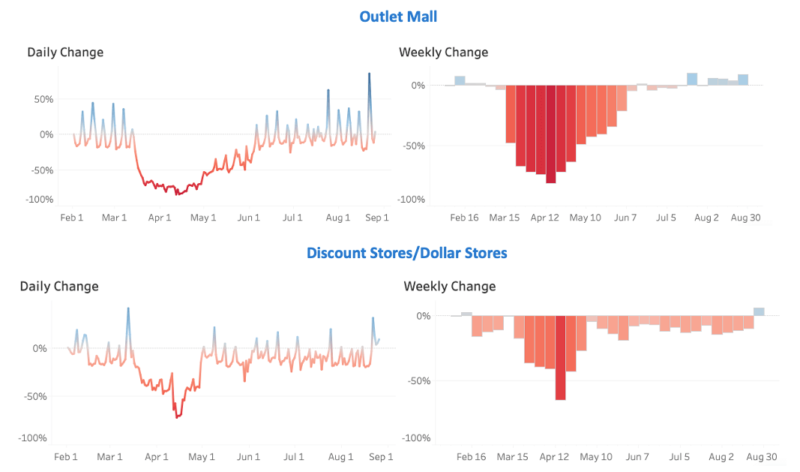
Foot traffic, ‘touch and feel’
Foot traffic data from Gravy Analytics shows, however, that discount stores and outlet malls have recovered better than department stores and traditional malls, as value-conscious consumers return in greater numbers to those in-person venues. As the chart above reflects, foot traffic for these two categories is at or above early February level before the lockdowns. However, department store foot traffic is down 15% and conventional malls are off 12%.
Past research has established why many consumers prefer shopping in physical stores (including Gen Z). According to the Mood Media survey consumers appreciate:
According to a separate study, 62% of shoppers are more likely to make e-commerce purchases if they can return the item in a local store. (And once there they tend to make additional purchases.)
This is the key point and a source of advantage for traditional retailers that sell online. Target and BestBuy, for example, reported triple digital e-commerce growth in the second quarter. But that was fueled in no small measure by the presence of stores.
The agnostic, ‘ROBO-BOPIS’ shopper
Beyond direct e-commerce, many shoppers are likely to use the internet as a tool to find products locally and help minimize time spent in stores. BOPIS and curbside pickup work to provide the immediate (or near-immediate) gratification of in-store shopping with the convenience and efficiency of online shopping. Shoppers can get the product locally today (and potentially return it tomorrow) without having to browse the aisles and locate the product on the self.
Bazaarvoice released a report showing that consumers are now more focused on shopping at local stores (read: SMB), whether online or off. It also reflects that the internet is playing a much larger role in offline shopping than ever. While people have been doing online research before buying locally since the early days of the internet, large majorities are now doing it — research online, buy offline (ROBO).
Beyond looking for directions, business hours or product and service reviews, this online-to-offline activity also shows up in product inventory checks. In 2019, according to a Google sponsored survey, 46% of shoppers confirmed inventory online before going into a store. In the midst of the lockdowns, Google reported that searches using the phrase “in stock” increased more than 70% during April. And while this includes online retailers, it’s aimed especially at local stores.
In this anxious environment, consumers don’t want to waste time or visit stores on the off chance they’ll find what they’re looking for. That’s why inventory data could be a difference-maker, whether in the form of Local Inventory Ads (LIAs) or product-specific landing pages for in-demand items.
Local ads and ‘showrooming’
In addition to LIAs, location-based mobile display ads generate store visits — and e-commerce sales. A 2019 study by Numerator and GroundTruth reported that 66% of those exposed to location-based display ad campaigns ultimately made a purchase in-store or online. Roughly 28% of that group bought from a competitor online or in a store. But among those going into stores, a whopping 94% made a purchase. The campaigns were for major retailers in three verticals: beauty, home improvement and mass merchandise.
Perhaps most interestingly, mobile users shown the campaigns were “25% more likely to make a purchase from that retailer online than those that are not shown an ad.” In other words, the ad promoting a local retail offer, generated online sales.
This illustrates the interdependency and symbiotic relationship of stores and e-commerce. Consumers are increasingly agnostic about whether they buy online or locally. But make no mistake, stores are critical in this equation.
Familiar brands and the presence of physical stores give people confidence to make online purchases, which they can then return locally if necessary. And in a post-COVID retail landscape, merchants may come think of their stores primarily as “showrooms” and fulfillment centers, where consumers can touch and feel or pick up products they ultimately buy online.
sep 4, 2020marketing
Microsoft Advertising expands LinkedIn Profile, dynamic remarketing, in-market audience targeting
B2B marketers can use LinkedIn Profile targeting in Search and Audience campaigns in more countries. Retail advertisers can retarget product engagers automatically with dynamic remarketing ads.
Microsoft is rolling out more access to three of its audiences targeting options. Here’s the rundown of what’s new.
LinkedIn profile targeting expands. Microsoft first opened LinkedIn Profile data for targeting on Bing in 2018, about two years after the company acquired LinkedIn. The beta was available in the U.S. With this release, LinkedIn Profile targeting by job function, industry and/or company are available for Search and Audience campaigns (for those with access) in the U.S., Canada, UK, Australia, France and Germany.
You can also use campaign bid modifiers for the specific industries or job functions of your target customers. The data encompasses more than 100 industries and 80,000 companies globally, according to Microsoft.
Dynamic remarketing for Shopping out of beta. After debuting last year, dynamic remarketing (formerly dubbed product audiences) is now out of beta.
When you associate a dynamic remarketing list with a Shopping campaign, you can retarget visitors to your site with Shopping ads of the products they viewed.
There are five types of dynamic remarketing lists currently supported. You can target general visitors to your product pages, product searchers, product viewers, shopping cart abandoners or past buyers.
Be sure to update your UET (universal event tracking) tag to include the custom events you want to track based on the types of lists you’re using.
Microsoft says the lists are kept current in near real-time. Customers are removed from Dynamic Remarketing lists “within minutes of purchasing a product” so you don’t wind up wasting ad spend (and annoying them) by showing the same ad. This is similar to Google Ads’ shopping retargeting lists.
In-market audiences in France, Germany. You can now use in-market audiences when targeting ad in France and Germany to reach users who have indicated purchase intent for certain products based on their search history and page views on Microsoft services.
You can associate in-market audiences with ad groups or campaigns.
There are more than 100 French audiences and more than 200 German audiences in verticals such as apparel, auto, financial services, home and garden and travel.
In the U.S., Microsoft added 47 new in-market audiences in July. There are now more than 700 in-market audiences available for the U.S.
Why we care. These audience targeting capabilities can help you both expand and refine your targeting and improve performance. LinkedIn Profile targeting is a capability unique to Microsoft Advertising.
sep 2, 2020marketing
Brands safety has so far focused mostly on media placement but with consumer concerns mounting around data privacy, marketers need to understand how toxic data can harm their brand.
Brands safety has so far focused mostly on media placement but with consumer concerns mounting around data privacy, marketers need to understand how toxic data can harm their brand.
This is according to Ogury South East Asia managing director Niall Hogan, who spoke to The Drum ahead of the Digital Summitand Drum Digital Advertising Awards APAC.
With many brands investing time and money into getting their data strategies fit for purpose, Hogan offers advice for brands on how they can protect the integrity of their brand, while still producing more personalised, effective digital advertising.
Data has been a huge topic for businesses for some time but in APAC, what level of understanding do most marketers have around data?
Marketers in APAC have a very good understanding of data, and how important data is to drive results for their business. However, they are facing increasing concerns about data privacy and protection. Concerns that have become a prominent topic for the digital advertising industry in APAC, as privacy breaches have reached main media news channels for the first time. In the coming months, local data legislation will also change, meaning the time to drive a fundamental shift in how the digital advertising industry approaches data collection is now.
At present, many marketers in APAC find that they are being forced to rely on third-party data to identify and reach consumers. But more often than not this data is unreliable, unconsented and passed through multiple hands before it is used - resulting in higher costs and lower accuracy for marketers overall.
Local marketers have to be sure that the data they’re using is reliable, consented by the user, and that they have reassurance on the traceability and validity of the user’s consent.
Ogury talks about the concept of ‘data safety’, what does that mean?
Data safety is all about ensuring that the data you’re using is safe, not toxic, for all digital advertising. When we talk about toxic data, we refer to any advertising data that is collected or used without the explicit permission of the consumer. So, by definition, safe data is any data collected or used with freely given and informed consent from the consumer, in compliance with all data privacy laws.
We often talk about how brand safety enables advertisers to appear in the right environment, protecting the integrity of the brand by ensuring it does not appear alongside harmful content. In much the same way, data safety is a concept that ensures that the data marketer’s use for advertising is safe from reputational, legal and financial risk and collected with trusted and traceable user consent.
A lot of marketers are very aware of brand safety and have a strategy for that but can the same be said for data safety?
We must raise awareness, and show that there is a real problem when it comes to data integrity. Brand safety issues - along with ad fraud - are often talked about, and can instantly ruin consumers' perception of brands. That’s why such a huge amount of time, money and technology is committed to tackling these problems. But now, as the digital advertising industry evolves, toxic data is also a threat to brands. As mentioned previously, this is any advertising data collected or used without the explicit permission of the consumer. And it is harming brands in much the same way.
Just as it’s imperative for marketers to ensure the media upon which their ads are shown is brand safe, so too must they ensure that the data they use for advertising purposes is safe. Verification companies have taken several years to educate the market on the need for brand safety and today we are on the same journey with data safety. If the term ‘traceable consent’ is not yet part of marketers daily, professional vernacular, I’m sure it soon will be.
Why is it something the industry should be talking about?
Gartner predicts that half of the world’s population will have its personal data covered by privacy regulation by the year 2022. Today, using toxic data in countries governed by privacy regulations isn’t just improper, it’s illegal. The collection, handling or use of consumer data without consent is now punishable by law - carrying huge fines. And this will soon be the case for all countries in the APAC region too.
Aside from the financial havoc that a data privacy fine can render, it’s the implications, including all the subsequent bad press that a brand could receive, that’s the real issue. How can consumers be expected to trust a brand with anything, if they can’t trust it with their data?
If marketers care about protecting their brand, they do not want to be associated with any of the legal, financial, or reputational risks associated with using toxic data. This is why data safety should be at the forefront of every marketer’s mind.
New concepts, such as data safety, come up often for marketers, how do you think brands can keep on top of changing issues like this? How can marketers keep up to speed on this topic?
Much like brand safety and fraud prevention, data safety is an issue that needs to be dealt with head-on, forming a critical part of marketer’s discussions, planning, strategy, and execution with all and any ad-tech partner they work with.
As most media agencies work as guardians to the advertiser’s brand, they are well placed to help marketers navigate complex concepts like this. A proactive marketer can ask their agency to speak to various suppliers who work in this area of expertise, or better still, ask the agency to organize an educational morning with suppliers who specialize in this specific topic. Most suppliers will be willing to invest their time to help raise awareness of such topics that are of vital importance.
This year has seen much change for the industry, how can digital help marketers keep up?
Even if the pandemic has slowed down the imposition of new privacy regulations, the industry is still facing increased scrutiny over its data practices. The pressure for marketers to comply with legislation is more prevalent than ever. Users are more aware of the value of their data online, with contract tracing apps being the latest test on privacy - failing in most countries so far.
For marketers operating globally, adapting practices to comply with all existing and upcoming legislation, and ensuring users are aware of the data value exchange is a real challenge. And if compliance wasn’t hard enough, marketers still need to grow their businesses and generate positive results from their digital investments - all with a major crisis and subsequent budget cuts occurring.
To keep up, marketers should partner with digital advertising technology companies that are well-versed on the topic of privacy, and ensure compliance with the highest standards of data privacy and protection.
source
aug 26, 2020social media
Exploring Instagram Reels for marketers: Not just a TikTok clone?
Introducing Instagram Reels; a new way of creating fun and engaging video content from Instagram Stories, distributed directly to your feed. So, what’s all the fuss about?
Introducing Instagram Reels; a new way of creating fun and engaging video content from Instagram Stories, distributed directly to your feed. So, what’s all the fuss about? Is it just a TikTok clone? Is it another example of owner Facebook aiming to take out the competition in the same way it introduced Stories as an alternative to Snapchat?
Well, yes and no. Instagram Reels has been in development for some time (since being trialled in Brazil late last year) and launched earlier this month in 50 countries, including the UK and US.
Yes, it would be naïve to think that the Facebook/Instagram empire doesn’t want to claim all eyeballs on its own apps, and the company is very comfortable with adapting to new social media trends to keep on top of the game.
But Reels is innovative and offers a number of benefits over TikTok (outside of the current situation regarding Trump’s hope of banning TikTok in the US). And for brands and influencers looking to engage with consumers and fans, there are some clear wins for Reels.
Firstly, the simple, user-friendly video editing interface enables brands, marketers and influencers to share short-form video content as quickly as they can with static content such as photography. You don’t really need *hours* of training to understand how to build and edit videos within Reels, unlike competitor TikTok which as a video editing app is far less user friendly and much more intricate for first timers especially.
And again, from a usability perspective, there are no restrictive caption limits, which makes adding important details far easier – for things like recipes, travel blogging, or stockist details. With TikTok, creators often have to use the comments section to tag on extra details or explanations which can make the uploading process far lengthier.
Similarly, there’s also the ability to tag an almost infinite number of other handles, including brands and creators, most of whom are most likely to already be on Instagram. All handles in captions are clickable making profiles easy to reach with a touch of a button, so there’s no need to pull people across to Instagram like there would be on other apps like TikTok.
Finally, in terms of editing, Instagram seems to currently have one up on TikTok when it comes to its huge music library. Recently brands were stripped of their rights to use popular tracks from artists on TikTok and now can only choose from a smaller library of stock music. Boring! Instagram still enables brands to choose licensed music to put over their videos, making for a much more engaging and fun viewing experience.
However, it’s most likely the environment – and the potential of Reels ’reach – which provide the biggest bonus over TikTok. Already we’re seeing richer, higher quality content from brands and creators on Reels, content which serves a deeper purpose than being made purely for the “lolz”. TikTok content, generally speaking, is pretty random, whereas the content we’ve seen on Reels feels more wholesome and in line with creators’ own content which they’ve already built up and perfected on their pages.
Instagram have also made finding content that suits you easier. And if your Reel is featured in Explore, you’ll receive a notification. These Featured Reels are a selection of public Reels chosen by Instagram to help you discover original content which the company state “will hope to entertain and inspire you”. Lovely stuff!
The Instagram audience, too, is an attractive one (in many senses) to brands. Gen Z-ers and Millennials – with their bigger disposable incomes – are more comfortable with Instagram; they already use it. And brands have the opportunity to see even greater reach to these desirable consumers with Reels over Instagram’s traditional feed.
In addition, influencers have been quick to jump to Reels. Some are continuing with TikTok too, but others – like Jessica Alba – have switched completely, giving a huge boost to the format. Indeed, British Vogue has already published an article on the top Reels influencers to follow – a huge seal of approval from the fashion and lifestyle publishing institution.
Let’s not forget too, that although TikTok has claimed all the headlines over the past few months, Instagram’s audience is still bigger. And the introduction of Reels has the potential to push it higher still, with many consumers feeling more comfortable with the format.
When Andy Warhol predicted that in the future everyone would have 15 minutes of fame, maybe he should have said 15 seconds.
source
jul 14, 2020seo
A study of billions of search results finds over a quarter of Google searchers click on the first organic result.
The first organic result in Google Search has an average click-through rate of 28.5%, according to a newly published study.
Sistrix analyzed over 80 million keywords and billions of search results to understand how users engage with SERPs.
Average CTR falls sharply after position one, the study finds, with the second and third positions having a 15% and 11% click-through rate respectively.
Unsurprisingly, the tenth position in Google has an abysmal 2.5% click-through rate.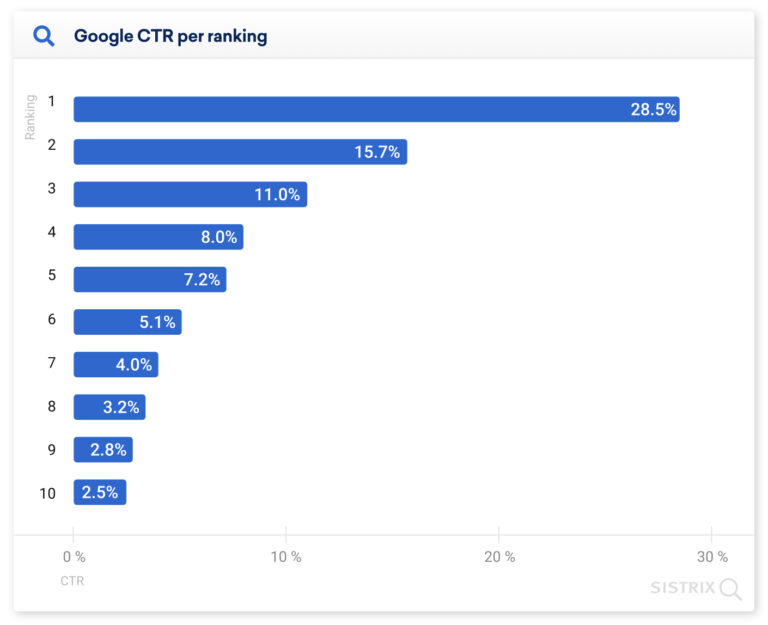
Beyond that, it’s well known users rarely venture into the second page of search results.
What’s less known are the massive differences in clicks between the first ten organic positions.
This study aims to further the understanding of CTR within the first page of Google search results.
Here are more key findings from the study, with information on what could cause the CTR for position 1 to swing between from 13.7% and 46.9%.
Google Search Click-Through Rates
It’s particularly important for SEOs to understand how the CTR of Google search results can be impacted
After all, many SEOs’ jobs involve ranking content on the first page of Google.
More crucial than ranking is driving traffic to those pages. What good is a first page result if no one clicks on it?
That’s where this study from Sistrix comes in, as it shows the amount of traffic generated by each position on page one varies wildly.
For example, a result in position #2 will generate an average of 3x more clicks than a result in position #6.
A result in position #1 earns a CTR over ten times higher than a ranking at position #10.
Results on the second page of Google have a CTR of less than 1% for each position. So this study only focuses on the first page of search results.
These are some of the factors that can impact the CTR of each position on the first page.
Factors Impacting Click-Through Rate in Google Search
The greatest factor impacting the CTR of Google search results is the SERP layout.
While a majority of queries will generate the traditional 10 blue links SERP layout, certain queries generate other types of layouts.
All the data referenced so far refers to positions within the 10 blue links layout.
Here’s information on other types of SERP layouts and their respective CTRs.
SERPs with Sitelinks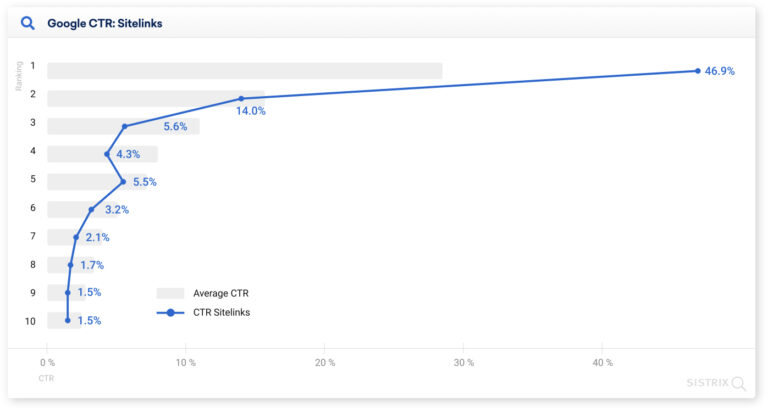
A sitelinks extension in search results is found to boost CTR.
A result in position #1 with a sitelinks extension will achieve a CTR of 46.9%.
This is likely due to the fact that sitelinks are shown by Google when a specific website is searched for.
So it makes sense that the top position of a SERP with sitelinks receives almost half of all clicks.
Featured Snippets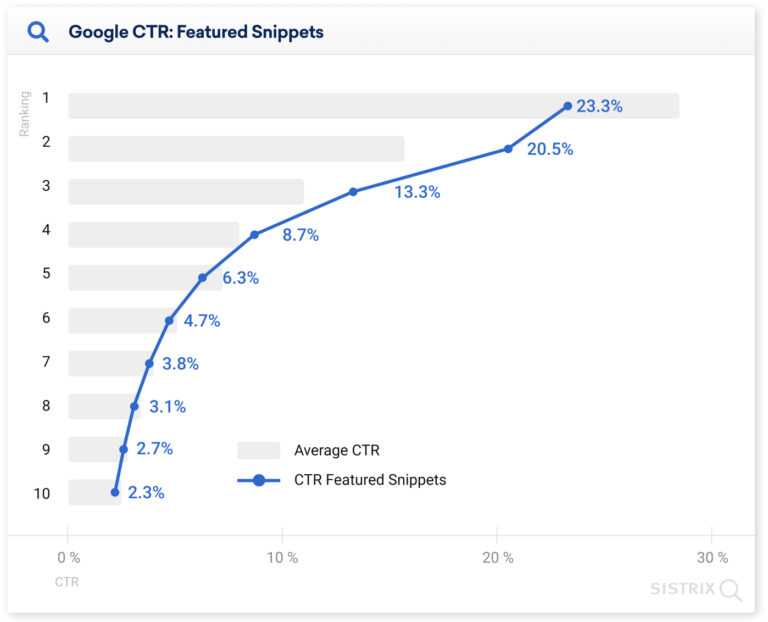
SERPs with featured snippets have a click-through rate that is 5.3% percentage points below average.
The study states there is no benefit to a web page displaying a featured snippet in search results.
In fact, positions #2 and #3 have an above average click-through rate when the first result returns a featured snippet.
Knowledge Panels
SERPs with knowledge panels take a hit in CTR as well, with the first position receiving only 16% of clicks instead of 28%.
The study states these SERPs receive fewer clicks because searchers get the answers they need in the knowledge panel.
“The CTR in the first two organic positions drops significantly compared to the average. Many users appear to find the information they are looking for in the Knowledge Panel – especially on their smartphones, where each time a page is loaded it takes a lot of time.“
SERPs With Google Ads
Click-through rate falls below average for all positions when the top of the SERP is full of Google Ads.
However, the Google Ads layout impacts organic results less than the knowledge panel layout does.
Google Ads reduce the CTR by 10 percentage points, compared to the 12 point reduction for SERPs with Knowledge Panels.
Other Notes
Those are just a few of the different SERP layouts examined by this exhaustive study.
Overall, the study proves keyword search volume is not the only factor that should be considered when evaluating potential clicks.
“As can be clearly seen in the analyses, the SERP layout of the keyword must also be included in the evaluation – only the combination of search volume and SERP layout results in a realistic number of potential visitors.”
source
jul 10, 2020marketing
Starting a Digital Business? Here Are Common Pitfalls to Avoid
A three-step plan for setting off in the right direction.
Image credit: aklionka | Getty Images
Starting an online business requires some planning. An entrepreneur needs to gauge demand, understand how SEO and digital ads work and know how to acquire customers cost-efficiently. If the formula works, the business can scale rapidly. As stated in the “Enabling Digital Entrepreneurs” report by World Bank Group, “many digital entrepreneurs are ‘born global’ and have the ability to grow and scale across borders very quickly.”
Online spending has skyrocketed in recent years, and continued growth is likely as people continue to stay home, which "creates huge opportunities for internet stores,” says Mathieu Jang in an interview. He’s the co-founder of Affiliate Institute, a Las Vegas-based digital marketing training firm that helps members grow revenue online.
Jang created a 12-week accelerator program that optimizes students’ affiliate-marketing practices. Aside from the technical aspects of ecommerce, he says it’s critical to have the proper mindset and remove notions of a personal limitation: “The world doesn’t happen to successful marketers. Top performers happen to the world.”
In the U.S., ecommerce now represents 16 percent of all retail sales, according to the Commerce Department. And Amazon.com accounts for more than one-third of ecommerce. Thus, a small business can potentially reach a massive audience. However, there are pitfalls to avoid.
1. Not understanding your target customer
You can burn plenty of cash by running ineffective ads. Bad marketing campaigns increase the cost of acquiring a customer, which is a crucial metric for a digital venture. There’s much noise on social and the web, which can confuse how novices approach campaigns. You need to truly understand the target audience in order to optimize ads. That means being effective with location, interests, design, calls to action and other factors that increase conversions and lower customer-acquisition costs.
The sales volume for merchandise is huge. For example, the online market for apparel, footwear and accessories will hit $4 trillion this year. Shopping on the web has also increased demand for online services like SEO, website building, graphic design and advertising. A high level of understanding means you’ve properly identified a niche. By knowing who’ll buy and who won’t, you can optimize a website’s content based on that niche, putting you in a better position to create the appropriate landing pages, newsletters, brochures and social posts to attract relevant traffic. When you publish better content, you’ll improve inbound marketing metrics, as well as increase user engagement.
Owners of physical storefronts had it easier because a target consumer was often someone who lived nearby or an adjacent town, but online obviously has no geographic boundaries. It helps to create a digital persona of who you’re targeting. What does your ideal shopper look and behave like? What style of clothing or shoes are they seeking? Which features matter most? You may be able to find profiling tools on social platforms that help to create target profiles. A business owner cannot successfully carve out a niche without identifying their customers.
2. Working as a lone wolf
It helps greatly to already possess knowledge of online practices like SEO, ads, ecommerce, email campaigns and social media best practices, but there can be frustrating blind spots. You may be good at running Facebook ads but flounder at writing landing pages. Or you may have high open rates on email campaigns but suffer low purchase conversions. Scott Smith, the founder of 7 Figure Surfer, said in a recent phone call, “During my six years working online, I often had to figure it out myself. I started from scratch and spent thousands of dollars in the process.”
Smith overcame these hurdles by getting a few mentors who showed solutions, as well as provided encouragement. A seasoned veteran can quickly teach entrepreneurs what works and what doesn’t, saving them headaches, time and money. It’s a good idea to attend conferences, meet-ups and networking events to exchange contact info with gurus. Leveraging other people’s expertise (in areas where you are weak) boosts the efficacy of campaigns. When setting up an ecommerce venture, small tweaks can pay big dividends.
3. Not outsourcing or using automation tools
Outsourcing enables business owners to cost-effectively tap the skills of independent contractors, streamlining the business because they’re better at specific tasks than you are. Virtual assistants free up time so you can focus on acquiring customers and providing after-purchase support. Hiring a video producer to create a popular TikTok video is a more effective use of time and budget than doing it yourself.
Or use a tool that’s saving business owners time. Neuro.net, the automation tool, acts as the outsourced call center for retail customers to get support from virtual agents in even complex conversations. And according to the company, it simulates human emotions so well that 99 percent of people don’t know they’re talking to a robot agent. Now that’s a bold claim for an automation tool, but data-processing company Powerry clearly believes it, given their recent $5.3 million dollar investment in Neuro.net. Nevertheless, it’s an affordable option for business owners who can’t quite afford full-time customer-support agents at their current growth stage.
It’s extremely important that business owners spend their limited time on activities that are crucial for success. Non-essential tasks should be delegated to others. An online business can reach global audiences and scale rapidly. Know your target audience, network with experts in a similar niche and build a team infrastructure that can scale your venture.
source
jul 7, 2020social media
Happy holidays? Why festive planning is earlier than ever this year
Brands love reaching their most passionate customers. As a former retail CMO myself, I get it...
Brands love reaching their most passionate customers. As a former retail CMO myself, I get it. When you reach early planners, you reach the CEOs of the household—an audience that buys and spends more. Reach them first, and you have a shot at being their first choice when it’s time to shop.
And yet, for as long as marketers and advertisers have been prioritising planners, they’re making some seriously incorrect assumptions about this key audience right now. I heard from a CMO recently: “I’m holding all of my holiday planning. Nobody is thinking that far in the future yet.” Right?
Wrong. Our latest research suggests the opposite. People on Pinterest aren’t delaying. They’re starting earlier than ever this year. That’s saying something, because at Pinterest, we’re used to early. As you can see in the graphic below, searches for “holidays” start appearing on Pinterest months before other search platforms.
But this year, Pinners are starting to search for holiday ideas even earlier than ever before. Historically, people on Pinterest start making holiday plans in September. This year, they started searching and saving for the holiday season… in April. Related searches jumped 77% in April 2020 vs. April 2019.
That trend included a 3x increase in searches for “Christmas gift ideas”—8 months before December.
Why the shift? First, there are the rational reasons. People are worried about the pandemic’s impact on preparations they used to take for granted. As one Pinner put it, “I’ll be starting to look online much earlier than normal because shipping delays are quite likely at the moment. You don’t know exactly when you’re going to see the products.”
But there are also more emotional reasons. After a tough year, consumers are craving the comfort of the Christmas holidays. And the early planning that once felt like a chore now feels extra special, and imbued with new meaning. One participant told us: “I really want it to be super Christmas-y and kind of over the top this year… I’ll be going above and beyond with tons of decorations and a tree and activities.”
Our research also shows that Pinners are explicitly looking for help from brands this year in navigating the shifting holiday climate while still making their celebrations feel special. As you develop content, think about designing specifically to meet customers’ early planning needs. For example, our research shows that Pinners who plan are also more likely to self-gift. This year, we predict they’re also more likely to host for the first time. Consider these different planner archetypes when crafting your content—from the self-gifter and the traditionalist to the shipping-first shopper and rookie host.
When we published our research this week, I shared it with the CMO mentioned above. Her reaction? “Look, we follow their lead. If our audience is early, we’ll be early, too.” Don’t be late to the party. Be the brand they discover first. Show up on time for the earliest holiday planning season ever.
source
jul 1, 2020marketing
When it comes to reaching new customers, an excellent paid media strategy starts with setting goals. If you don't know where you're headed, how do you know where to go?
This article was written by Alex Sixt, an Entrepreneur NEXT powered by Assemble expert. If you are looking to take the NEXT step in your business then we encourage you to check out Entrepreneur NEXT powered by Assemble.
Do you want to grow your business and reach more audiences that convert into leads? Then a tactic that can help expand your business is paid media, a method of using promoted (paid for) content such as social media posts, video ads, pop-ups, etc. to reach target audiences. Essentially, paid media is content that businesses pay for to reach more people.
For some, dipping their toes into paid media is intimadating, however, with understanding of best practices, you're experience will be much more enjoyable. Here are a few tips to get you comfortable with paid media.
Establish goals.
An excellent paid media strategy starts with setting goals. If you don’t know where you’re headed, how do you know where to go? To start building a paid media strategy, you’ll need a basic understanding of Key Performance Indicators (KPIs). KPIs are a measurable value that indicates progress in achieving the overall goal. Some examples of KPIs are impressions, conversions, and website traffic. These metrics can give you insight that helps determine how well your content is performing.
If you’re still unsure how to develop a list of goals and KPIs for your paid media campaign, consider what the overall goal is that you’d ultimately like to achieve through this content. What are you advertising? How are you hoping your business benefits from your ads? Keep your vision in mind and let it guide your objectives.
Build a keyword list.
Keywords are a tactic used to get your content in front of your target audience. The success of your paid media content depends on keywords because they help you reach as many potential customers as possible. Conduct extensive research into keywords to be sure they’re relevant to your business and advertisement.
As you continue to publish paid media ads and campaigns, update your keyword list with terms that perform well. If a keyword hasn’t been successful in reaching your target audience, toss it out so it doesn’t affect your ads negatively in the future.
Choose your channels.
Not all of your audience loves Tik Tok, or any other channel as a collective group. Every consumer is different in their preferences, and you’ll want to cater to that by selecting the channels for your paid media carefully. Research—the magic word—can help you to understand which channels should successfully reach your audiences. Google is a great platform to include, but go beyond the obvious and search out what channels your audience spends time on.
If you’re targeting ads at a Gen Z audience, consider Tik Tok or Instagram, which has become a wildly popular platform for paid media due to influencers and the visual aspect posts provide. Or, let’s say you’re advertising a service that’s used by working professionals—LinkedIn should be one of the first channels on your list. It’s overwhelming to think of all the places your audiences could potentially be (virtually) hanging out, but with some research and intuition, it’ll become easier to narrow down the list as you go along.
Create landing pages.
So, you’ve created a beautiful ad and a potential customer has clicked on it, but where do they land? The answer isn’t your website’s homepage (sorry to disappoint). The user should find themselves at a landing page. If you’re unfamiliar with the term, a landing page is a webpage that is dedicated to converting leads. Designing a landing page that is relevant to your paid media will keep a clean, consistent transition and experience for the user.
Along with including content that is relevant to your paid media ad, make sure your landing page is engaging as well. Users should want to take the desired action on your page, whether that’s entering an email or purchasing your latest product. Track conversions from your landing page to help you adjust for better performance as needed.
Optimize your ads.
As your paid media ads run over time, you’ll learn more about your audience and exactly how to reach them successfully. This information is like gold—and arguably more valuable. Use the insights you gain to improve targeting for future ads and campaigns. Tweaks you may need to make include refining your message or editing the design to make your ad stand out more.
Adjusting your ads as you learn more about audiences is crucial to building successful paid media content. There’s a learning curve to monitoring your audience’s behavior, but don’t let that scare you away. Any optimization you can provide for ads should help you generate leads, so keep your chin up and post on!
Measure your ads.
The only way to know how your content is truly performing is by tracking their success. Remember KPIs? Great, here’s where you’ll put them to use.
Measuring how your paid media performs is vital to the continued success of your ads. Decide your how often you’d like to measure your ads (weekly? monthly?) and study how your ads have performed against the KPIs you selected.
Not all ads will perform incredibly as soon as they’re launched, and that’s okay. Learn from the results of your analytics and be easy on yourself; not everyone is an expert right away. Work through what works best for your paid media, and continue to build a strategy from there.
Hire an expert.
If you’ve read the above and think you still may need more help beyond this blog, there are paid media experts that will take care of your content for you. Running a business takes a lot of time, and creating an effective paid media campaign is a full-time job. Paid media experts have extensive experience in this area, and can accomplish any related tasks without you having to do anything beyond hiring them.
So, how do you go about hiring a paid media expert? You can either go through a service that offers paid media help or search for one on your own. Both are great options, finding an expert may be time-consuming and present difficulties when it comes to paperwork, expenses, benefits, etc. When choosing a service to find your expert, ensure they vet talent ahead of time and can verify applicable experience.
If you’re wondering where to begin with paid media, there are plenty of best-practice guidelines to help you start successfully. Remember to have fun with creating your content. Once you’ve done your research and established a foundation, experiment with various designs to help your paid media stand out. And should you ever need extra help, remember there are experts that can help with the task.
source
jul 1, 2020social media
Target, Mars, Volkswagen join Facebook ad boycott as list tops 240 brands
Target, Mars and Volkswagen have joined the boycott, according to various reports, bringing the total list of boycotting brands to more than 240.
UPDATE: July 1, 2020: Target, Mars and Volkswagen have joined the boycott, according to various reports, bringing the total list of boycotting brands to more than 240. In addition, Molson Coors will pause advertising on Facebook, Instagram and Twitter, while Anheuser-Busch does not plan to take part in the boycott "as of now," according to Ad Age.
UPDATE: June 30, 2020: Adidas, Beam Suntory and Colgate-Palmolive have joined the boycott, according to Stop Hate for Profit. In addition, HP announced that it is stopping U.S. advertising on Facebook, and The Clorox Company announced it will stop advertising with Facebook through December. Microsoft reportedly suspended its advertising on Facebook and Instagram in the U.S. in May and recently expanded that to a global pause, according to Axios.
Brief:
- Coca-Cola, Hershey, Diageo, Levi Strauss & Co. and Birchbox are among the brands that joined the Stop Hate for Profit boycott of Facebook organized by the Anti-Defamation League (ADL) and other civil rights organizations, according to the website for the boycott. The list of participating companies includes nearly 100 names as of June 29, as more marketers pledge to not buy ads on the platform in July amid concerns about its role in spreading hate speech and misinformation.
- Coke extended its strategy to pause paid advertising on all social media platforms worldwide for at least 30 days, per a statement by Chairman and CEO James Quincey. The executive asked for greater transparency and accountability from social media partners, as the soft-drink company reassesses whether to change its advertising policies in a broader sense. Archrival PepsiCo has also quietly joined the movement, Fox Business reported.
- Starbucks, which hasn't officially joined the #StopHateForProfit boycott, still announced plans to pause advertising on all social media platforms over the weekend, and said it will hold both internal discussions and discussions with outside media outlets and civil rights groups on how to curb hate speech. The coffee chain will keep posting to its social media channels without paid promotion, CNBC reported.
Insight:
What started as a call by civil rights groups to boycott Facebook in July has attracted an outpouring of major advertisers, including Unilever and Honda, and is now widening to cover the social network and its rivals, according to dozens of announcements and press reports in recent days. The boycott movement follows weeks of growing tensions between advertises and Facebook over its content-moderation policies since the killing of George Floyd while in police custody spurred global calls to end racism and police brutality.
While the growing movement has the potential to impact social media more broadly, Facebook — the largest social media platform by users and revenue — remains the primary focus. Advertisers are questioning whether they want to support Facebook, which several civil rights groups this month accused of profiting from divisive hate speech. The ADL, National Association for the Advancement of Colored People (NAACP), Color of Change, Common Sense, Free Press and Sleeping Giants partnered in the #StopHateforProfit campaign that asked businesses to stop advertising on Facebook in July. Some, like Unilever, have broadened the timeframe, with the CPG giant on Friday announcing it would pause all social media advertising on Facebook and Twitter until "at least" the end of the year.
Amid the growing pressure from marketers, Facebook on Friday said it would begin labeling political speech that violates its rules and take other steps to curb voter suppression and protect minorities from abuse, The Wall Street Journal reported. In a statement to the newspaper, Facebook said it spends billions of dollars a year on safety measures, and has banned 250 white-supremacist organizations from Facebook and Instagram. After Facebook's announcement, the Stop Hate for Profit campaign published a list of demands for Facebook to improve accountability, decency and support for victims of harassment, saying that the steps announced by Facebook don't go far enough.
The Facebook boycott has gained momentum since June 17, when the organizing groups took out a full-page ad in the Los Angeles Times that accused Facebook of allowing the incitement of violence against protesters "fighting for racial justice in America," giving white nationalists a platform and ignoring efforts to suppress voter turnout.
Outdoor retailers The North Face, Patagonia and REI were among the first companies to announce their support for the movement to boycott Facebook, followed by Unilever, American Honda, Verizon, Ben & Jerry's, Eddie Bauer, Levi Strauss and Canadian outdoor goods company Arc'teryx. Ad agency Goodby Silverstein also supports the movement. It's possible that many brands already had reduced their ad spending because of the coronavirus pandemic and economic slowdown, and joining a boycott is one way to show support for a social cause.
It's too early to tell how the boycott movement will affect Facebook, which is facing its biggest crisis since the Cambridge Analytica scandal invited scrutiny of the social network's effect on elections and resulted in a record $5 billion fine. Facebook has a diverse revenue base among 8 million advertisers worldwide, though many smaller businesses have faced serious threats from the coronavirus pandemic and resulting lockdowns.
Facebook has said that it doesn't make policy decisions based on revenue pressures, but it is working to persuade its biggest advertisers from halting their ad spending, per a separate Wall Street Journal report. Facebook executives have said in calls and emails with advertisers that they take the demands of civil rights groups seriously, the newspaper reported.
source
jun 30, 2020seo
Backlink checkers cost a lot? Not necessarily. Check out these 5 free tools that do the job no worse than their paid alternatives.
Website and page authority, as defined by the number and quality of backlinks, is one of the most important search ranking factors. It is also one of the search engine optimization areas where you can gain the most advantage over your competitors. Sure, there are also technical and on-page SEO, keyword research, and content optimization, but there is only so much you can improve in these areas. With link building — the sky’s the limit.
This is why it is crucial that you are equipped with the best backlink tools. The best backlink checker will enable you to spot new link-building opportunities, discover the strategies of your competitors, and monitor the health of your backlink profile. In this post, we will focus on some of the best backlink checkers on the market, with one added condition - they have to be available for free, either completely or at least partially.
1. SEO SpyGlass
One of those backlink analysis tools that can truly do it all.
SEO SpyGlass provides you with a fully specced-out dashboard for backlink analysis and management. Unlike other free checkers, SpyGlass allows you to sort and filter the discovered backlink data using any of the several dozen backlink parameters:
The number of backlinks you can view for free is limited to 1,100 per domain, but the number of domains you can check is unlimited, so you can research your own websites as well as your competitor websites. And if you want some additional data, there is an option to connect SEO SpyGlass to Google Search Console and Google Analytics. Once connected, you will be able to pull your backlink information from Google tools, pour it into SEO SpyGlass, and process the data using the SEO SpyGlass dashboard — free of charge.
And when it comes to discovering new backlink opportunities, SEO SpyGlass is equipped with a feature called Domain Comparison. Add a few of your competitors and find the websites where their backlinks intersect. These websites are your immediate leads. Since these websites are linking to two or more of your competitors, it means that they do not have a particularly exclusive partnership and will probably agree to link to you website as well.
Best for: with advanced analytics and the largest data allowance on this list, SEO SpyGlass is best used as your home base for backlink research and management.
Free data allowance: up to 1,100 backlinks per domain, unlimited domain checks, unlimited backlink analytics.
2. Google Search Console
A completely free backlink tool with a large data allowance, but limited opportunities for backlink analysis.
Search Console is a Google tool meant to help webmasters improve their websites. It is completely free, but can only be used to analyze the websites that you own. Once you get your ownership verified, you will be granted access to a variety of site quality dashboards, one of which is the list of backlinks drawn directly from Google’s index. However long the list, you can only view the top 1,000 results. No additional metrics and no analytics features are provided on-site, but you are free to export the data and analyze it using other tools.
A peculiar thing about Search Console is that its backlink lists are usually much shorter than the ones from other backlink checkers. It’s because Search Console removes low-quality backlinks from the list and only counts the ones that matter. This type of vetting means you can’t use the tool to catch spammy backlinks and remove them from your profile. But, on the bright side, it also means you receive a set of backlinks very different from other tools.
Best for: Google Search Console is best used as a source of raw backlink data, which can then be exported to SEO SpyGlass for analysis and additional insights.
Free data allowance: up to 1,000 backlinks, but you can only check the sites that you own.
3. Seobility
A perfect tool for a quick review of your or your competitors’ backlink profiles.
Seobility allows up to three backlink checks per day and limits the number of backlinks you can view to 400 per check. The list of backlinks is sorted from the highest link rating to the lowest, so, even though the number of links you can view is limited, you do get to see the best ones.
The links are accompanied by a few additional parameters, like anchor texts, dofollow/nofollow attributes, link types, and linked pages. At the top of the page, you also get a quick summary of the overall backlink profile: total backlink count, domain rating, and the number of referring domains.
Best for: Seobility can be used in two ways. One is to check your own website and perhaps find some of the links missed by Search Console and SEO SpyGlass. Two is to run a quick check of your competitor’s backlinks and gain an insight into their strategy.
Free data allowance: 400 backlinks per check, three checks per day.
4. Ahrefs
A popular link checker tool that draws data from one of the largest backlink indexes.
Ahrefs backlink checker allows an unlimited number of checks per day, but the number of backlinks you can view is limited to the top 100. Backlinks come with some additional metrics, like domain and page authority, traffic, and anchor text and type. There is also a quick review of the overall backlink profile: domain rating, the total number of backlinks, and the total number of referring domains.
Best for: use this checker interchangeably with Seobility for a quick exploration of your own or your competitor’s websites. Use Ahrefs first because it doesn’t have a daily limit. If it looks like there might be something interesting beyond the first 100 backlinks, switch over to Seobility to retrieve another couple hundred backlinks available over there.
Free data allowance: 100 backlinks per check, unlimited checks per day.
5. SEMrush
The best tool for generating high-level backlink reports and domain summaries.
Most of the tools on this list try to attract users by allowing them to see partial backlink tables and then asking for a payment to check out the rest. SEMrush has gone in a completely different direction. It shares a ton of backlink analytics, but no backlink lists. So you are free to explore the high-level stuff, but, if you want to drill down, you’d have to buy a subscription.
This is perfectly fine because high-level analytics is about the only thing missing from most of the other free backlink checkers. And SEMrush has got plenty to go around. They offer over a dozen of tables and graphs summarizing your backlink profile: backlinks by industry, by country, by top-level domain, attribute, type, anchor, and authority score, as well as backlink history going back over five years.
Best for: SEMrush is a great tool for generating quick, attractive-looking reports and taking the bird’s-eye view of your or your competitors’ link-building effort.
Free data allowance: unlimited reports, but only 5-10 actual backlinks per domain.
Final thoughts
One of the trade-offs of using free SEO tools is that you might have to sacrifice some of the convenience. In the case of backlink checkers, it could mean using a combination of different tools in order to satisfy all of your backlink research needs.
Of the link checker tools discussed in this article, the majority of your needs will be satisfied with a combination of SEO SpyGlass and Google Search Console. The analytics in SEO SpyGlass can be used to compensate for the lack of metrics in Search Console, while Search Console data can be used to combat the backlink limit in SEO SpyGlass. Together, these two make a solid home base for monitoring and managing your own backlink profile and some spying on your competitors.
Other than that, the free versions of Seobility and Ahrefs can be used for quick but limited backlink extraction, while the free version of SEMrush can supply much-needed analytics and reporting. Together, these three make a perfect combo for spying on your competitors and uncovering their backlink strategies.
source
jun 26, 2020social media
For most, LinkedIn Ads works best if you focus on getting people into your funnel - not on getting them to buy today.
When it comes to B2B marketing, there are a lot of reasons to love LinkedIn. There’s no other social media platform quite like it.
I mean, where else can you specifically target key decision-makers based on the size of their business, industry and all kinds of other handy criteria?
On LinkedIn, over 690 million professionals eagerly share all kinds of information about themselves. They come to the platform looking to learn, share, and discover business opportunities.
It’s a B2B marketing wonderland.
The only problem is, advertising to decision-makers on LinkedIn isn’t nearly as straightforward as marketing to consumers on Facebook is. So, while LinkedIn Ads seems like a dream come true for B2B businesses, for many, it can be hard to turn all of that potential into a profitable reality.
In years past, LinkedIn Ads itself only made things more difficult for B2B marketers. It was beset with a variety of problems and limitations that have left the platform with a bit of a bad reputation. Thankfully, the platform has come a long way, but it still isn’t right for many businesses.
This leaves many B2B companies in a bit of a conundrum. Is LinkedIn Ads a good investment? Or should they focus their efforts elsewhere?
After running LinkedIn Ads campaigns for dozens of B2B businesses at my marketing agency, we’ve put together a list of questions that you can use to help determine whether or not LinkedIn Ads is a good fit for your business. Let’s take a look.
Is your business making the most of other marketing channels?
In my experience, LinkedIn Ads is a great high funnel marketing tool. LinkedIn users visit the platform to learn, not to buy products or services.
As a result, it’s not a great place to get started with marketing.
When you’re first building out your marketing funnel and figuring out your messaging, it can be a pretty steep learning curve. That’s true no matter what platform you start with.
If you start with LinkedIn Ads, it’s going to cost a pretty penny. On average, most businesses will pay about $5.74 per click.
And that’s for a high-funnel, low-intent click.
Taking average conversion rates into account, you can probably expect to pay around $90 per conversion—probably for an eBook download or something similar.
By comparison, a conversion in Facebook’s priciest industry—technology services—averages a $55.21 cost-per-conversion. That’s still not cheap, but it’s a much more affordable way to cut your teeth.
So, if you haven’t maxed out your results on Google Ads, Facebook Ads, and any other relevant platforms, that’s probably a better place to focus your efforts. Could you get great results from LinkedIn Ads? Yes, but it’s a gamble.
On the other hand, if you’ve really nailed your marketing strategy on other, more affordable platforms, you’re in a great position to make the most of LinkedIn Ads. You know how to approach your target customers and you’ve already got the cross-channel setup you need to capitalize on the clicks and conversions you get from LinkedIn.
In this situation, you’re perfectly positioned to use LinkedIn Ads to bulk out your marketing funnel. Because it’s so high-funnel, LinkedIn Ads will take some time to produce results, but if the rest of your marketing is humming along nicely, it can be a good way to expand things and grow your business.
Can your profit margin handle the cost of LinkedIn Ads?
LinkedIn Ads is pretty pricey for an upper-funnel marketing channel. While it can deliver direct sales for some businesses, for most, LinkedIn Ads works best if you focus on getting people into your funnel—not on getting them to buy today.
However, if you’re paying $90 to get someone into your funnel, you need a decent amount of profit margin to handle that kind of upfront expense. Not every decision-maker that fills out your lead magnet form will become a customer, after all.
Unfortunately, if it costs $90 per form fill and only 10% of those form fills turn into paying customers, you’re paying $900 per new customer.
For some businesses, that would be a slam dunk. For others, it would bankrupt them.
Obviously, these figures are just hypothetical estimates. Your costs will be specific to your business, what you’re selling, and who your target customers are.
The important thing is to take a hard look at what you can afford to spend to get a new client or customer. If you make less than five hundred dollars per customer, LinkedIn Ads may not be a good fit. If you make thousands in profit off of the right customers and LinkedIn Ads will get you in front of your ideal audience, it may be a great option to try!
And, if you’re somewhere in the middle, you may want to focus on improving the efficiency of your funnel first. Often, with the right nurturing strategy and email campaigns, you can milk a lot more out of your marketing. Once you get that side of things working better, LinkedIn Ads may suddenly be a lot more interesting.
Until you actually start running ads, it’s all a bit hypothetical, but if you’re having a hard time making LinkedIn Ads make sense on paper, there’s a good chance it won’t work in practice, either.
But, if it seems like LinkedIn Ads could be a cost-effective way to get in front of your ideal customers, go for it!
Does Bing Ads work for your business?
The more well-developed your overall marketing strategy is, the better LinkedIn Ads works. In our experience, this is particularly true for businesses that are using Bing Ads.
Since Microsoft owns LinkedIn Ads and Bing Ads, there are a variety of interesting ways to use that connection to get better results from your marketing.
For example, as you identify your ideal target audience on LinkedIn, you can use that knowledge to add LinkedIn profile targeting to your Bing Ads campaigns. That way, you can deliver custom, highly-focused messaging to your ideal customers when their purchase intent is the very highest.
Of course, Bing only accounts for around 33% of online search volume in the United States and just 9% of search volume globally. So, if your target market isn’t very big, Bing Ads may not be a great channel for your business.
But, if your target audience covers thousands of potential businesses, combining LinkedIn Ads and Bing Ads can yield great results. It doesn’t work for every business, but it can be a great option to consider.
Do you have a good content marketing strategy?
Content is the language of LinkedIn. As we’ve already discussed, people don’t come to LinkedIn to buy—they come to learn, network, and discuss.
To get good results from LinkedIn Ads, you need to respect that.
On LinkedIn, most direct-sales campaigns are too much, too soon. Instead, it usually works best to focus on sharing high-value content. Blog posts, videos, podcasts, and gated content is the best way to engage with your future customers.
Ask them to buy, and you’ll probably scare them away. But, offer them valuable insights and suggestions on how to improve their business, and you’ve got a decent chance of getting them to click…and hopefully convert.
However, to do all of that, you have to have valuable insights and suggestions on how to improve their business to share. If you don’t already have good content, it’s going to be hard to get good results from your LinkedIn Ads campaigns.
In addition to a great content strategy, you should also have a solid email and nurturing strategy in place before you invest in LinkedIn Ads. There’s no point in spending $90 to get someone’s email address if you aren’t going to do anything with it.
If you don’t have great supporting content yet, you’re not ready for LinkedIn Ads. It’s as simple as that.
Is LinkedIn Ads right for your business?
So, is your business ready to start using LinkedIn Ads? Maybe…or maybe not.
If you’re just figuring out your online marketing strategy, now probably isn’t a great time to invest in LinkedIn Ads. You’ve got a lot to figure out and LinkedIn advertising is an expensive, slow way to get started.
Even for businesses that have a dialed-in marketing strategy and are looking for ways to bulk out their funnel, LinkedIn Ads still may not be right. If you don’t have enough profit margin to handle the cost of marketing on LinkedIn, you’re probably better off investing in other channels.
But, if you’ve got the profit margin and you have a solid, cross-channel marketing strategy supported by effective email marketing campaigns and great content, LinkedIn Ads is a solid option to consider. Throw Bing Ads into the mix and things get even better.
Now, these rules aren’t set in stone. We’ve seen a number of businesses thrive on LinkedIn that didn’t fit these criteria exactly. But, as a general rule, if you’ve read through this article and don’t feel great about your odds, listen to your gut.
On the other hand, if you read through this article and thought, “You know, my business sounds perfect for LinkedIn Ads,” don’t be afraid to dive in! For the right companies, LinkedIn Ads is a great way to grow your business.
source
jun 26, 2020ecommerce
Research from the Baymard Institute shows that nearly 70 percent of online customers leave items in their carts without making a purchase.
Research from the Baymard Institute shows that nearly 70 percent of online customers leave items in their carts without making a purchase.
Customers abandon carts for a variety of reasons, and there is no guarantee that they’ll remember to come back once they’ve left. Luckily, businesses aren’t helpless when it comes to reconnecting with these customers. Cart abandonment campaigns let businesses give a second pitch for their products and have another point of engagement.
Here are five reasons why it’s worth trying a cart abandonment campaign today.
Reason #1: eCommerce is growing
During the 2010s, eCommerce sales grew by an average of 15 percent every year. Today, they account for 16 percent of total U.S. retail sales. This rate of growth far exceeds traditional retail growth in the past decade.
The COVID-19 pandemic has also caused a spike in ecommerce. Online orders have increased 56 percent since its start. This means more people are shopping online now than ever before.
With a bigger pie of potential ecommerce transactions, there’s greater opportunity to bring in – and lose out on – revenue. An effective cart abandonment solution will allow you to convert more people in the ever-growing population of people shopping online.
Reason #2: Improve your chances of conversion
In our experience, a cart abandonment campaign can increase conversions by about 20 percent. It allows you to address the many reasons why a customer might leave their cart and ensure you’re not missing out on easy opportunities.
For instance, maybe a customer simply forgot about your product or got distracted before checking out, even though they’re still interested. Sending a reminder could result in an easy conversion.
Another common reason customers leave is additional fees like shipping. With a cart abandonment campaign, you can test messages offering free or discounted shipping, which may win back some customers.
Reason #3: Emails still work
Even though they’ve been around since 1971, emails remain a popular form of communication. Nearly 76 percent of all US adults use email at least once a month.
This makes email a powerful marketing tool. According to MailChimp, customers open one out of every five marketing emails sent.
Cart abandonment emails can be particularly effective because they target a group of customers who have already shown an interest in your products. An email that re-offers a product with an added incentive could give customers that small nudge they need to make a purchase.
The best emails also contain a personal touch that focuses on a customer’s specific interests and shopping habits. Which brings me to…
Reason #4: Event-based emails lead to more sales
Emails that are sent based on a “triggering” event (like an item being left in a cart) perform three times better than nurture or batch emails.
Cart abandonment emails are by nature linked to a specific thing your customers just did, which means they’re highly personalized and relevant to your customers’ lives.
Because these emails are so likely to get customers’ attention, they’re also a great opportunity to cross-sell or upsell. You can do this by leveraging the power of AI in your cart abandonment strategy to send emails that feature “people also bought” or “people also looked at” content.
This helps recapture customers’ attention through relevant, value-driven messages.
Reason #5: There are few risks and many rewards
As with any marketing strategy, you can run trials with your cart abandonment campaigns. Experiment with various discounts and promotions based on specific products and customer groups to develop unique approaches for each.
There’s not much downside to sending an email, either. As long as your emails are compliant with global best practices, can be navigated easily, and provide value to your customers, the worst that could happen is that your email gets ignored. On the other hand, converting even 10 percent more people with a campaign would be a huge boost for your business.
Conclusion
An effective cart abandonment campaign can help you recover lost opportunities and maintain important customer relationships. It’s a must-have for any eCommerce business looking to grow revenue and develop a network of loyal customers.
source
Actualités
Coperon Technologies
© 2000 - 2025 Coperon Technologies. Tous droits réservés.


